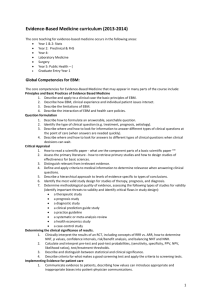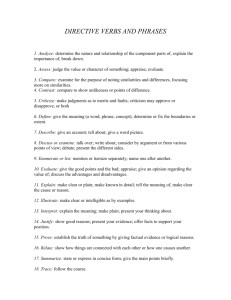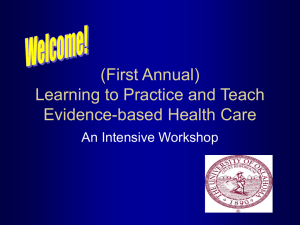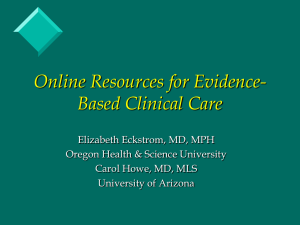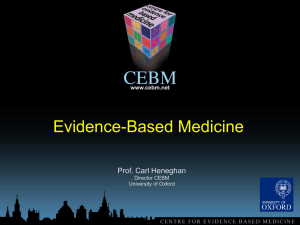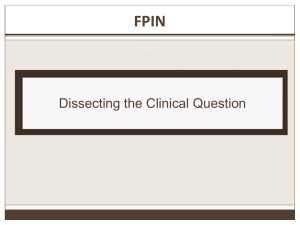Intern Orientation PowerPoint Presentation
advertisement
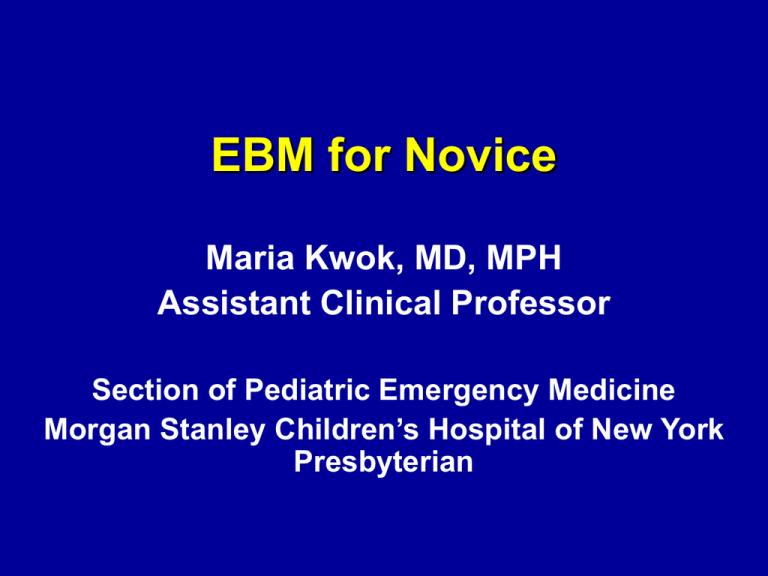
EBM for Novice Maria Kwok, MD, MPH Assistant Clinical Professor Section of Pediatric Emergency Medicine Morgan Stanley Children’s Hospital of New York Presbyterian Outline • Why is EBM important? • What is EBM • Understand foreground vs. background questions • Formulate PICO questions • Find resources, do searches • Validity of an article • Appraise “Therapy” articles • Appraise “Diagnostic” articles Why is EBM Important? • MEDLINE – 400,000 new entries added each year • To keep up-to-date – Need to read 6,000 articles each day Why is EBM Important? Lag time from time of “knowing” to time of “implementation” – 13 years for thrombolytic therapy – 10 years for corticosteroids for acceleration of fetal lung maturity (Antman EM, JAMA, 1992) Traditional Approaches Self-reported reading time per week. (University setting) – Medical students – Interns – Senior residents – Fellows – Attendings graduating • Post 1975 • Pre 1975 60 min. none 10 min. 45 min. 60 min. 30 min. There is simply no way we can keep up to date in medicine using traditional approaches! Outline • Why is EBM important? • What is EBM? • Understand foreground vs. background questions • Formulate PICO questions • Find resources, do searches • Validity of an article • Appraise “Therapy” articles • Appraise “Diagnostic” articles Quiz: Define EBM A) A means of camouflaging biostatistics in medical training B) An annoying and overused catch phrase C) The conscientious, explicit, and judicious use of current best evidence in making decisions about the care of individual patients Research Evidence Decision Making Clinical Expertise Patient Preference Evidence Based Medicine: A Process Patients Appraise Ask Questions Searching Validity Results Applicability Outline • Why is EBM important? • What is EBM • Understand foreground vs. background questions • Formulate PICO questions • Find resources, do searches • Validity of an article • Appraise “Therapy” articles • Appraise “Diagnostic” articles What’s the difference between foreground and background questions? Asking the Precise Question • Background questions • Basic aspect of a disease • Pathophysiology • Etiology • Basic treatment • Who, what, when, how • Foreground questions • Specific knowledge • Have 4 parts: •Patient/problem •Intervention •Comparison intervention •Clinical outcomes Background or Foreground? • What is asthma? • Is prednisone helpful in asthma? • What are the newest medication for asthma? • Does atrovent used acutely make you feel better? Background or Foreground? • What is asthma? (B) • What are the newest medication for asthma? (B) • Does atrovent used acutely make you feel better? (F) • Is prednisone helpful in asthma? (F or B) • Foreground if compare to other drugs • Background if interested in how it works Outline • Why is EBM important? • What is EBM • Understand foreground vs. background questions • Formulate PICO questions • Find resources, do searches • Validity of an article • Appraise “Therapy” articles • Appraise “Diagnostic” articles Structure of a Well-built Question • Patient or population • Be specific to capture the group you want • Ex: Children w/ asthma • Intervention • Be specific • Comparison group (if any) • Compare to standard therapy or test • Outcome • Be precise • What are the outcome of interest Formulating the Clinical Question PICO Patient In patients with asthma discharged home from the emergency department Intervention does the use of both inhaled and oral corticosteroids Comparison (if relevant) compared with oral steroids alone Outcome lead to a reduction in asthma relapse? Can You Identify PICO? • In children under 6 months, how does sleeping on back compared to sleeping on the stomach in terms of risk of SIDS? • In children under 6 months (P), how does sleeping on back (I) compared to sleeping on the stomach (C) in terms of risk of SIDS (O)? Can You Form a PICO Question? Clinical scenario: 5 yo with moderate persistent asthma now in severe acute asthma exacerbation. Intern gave 2 albuterol and orapred with minimal improvement. Intern asks why how good is atrovent? Searchable PICO Question P: Population I: Intervention/diagnostic test/risk factor C: Comparison O: Outcome In children with acute asthma exacerbation (P), will the addition of atrovent (I) to albuterol (C) decrease the rate of hospitalization (O)? Outline • Why is EBM important? • What is EBM • Understand foreground vs. background questions • Formulate PICO questions • Find resources, do searches • Validity of an article • Appraise “Therapy” articles • Appraise “Diagnostic” articles Searching Superhero Best Bets The Evidence Pyramid If your question is about… Look for a … Intervention/Therapy • Randomized controlled trial Diagnosis/Screening To assess the accuracy of the test • Cohort study To assess effect of test on health outcome • Randomized controlled trial Prognosis •Longitudinal cohort Etiology/Risk factors • Randomized controlled trial • Cohort • Case-control Pre-appraised Resources • Cochrane – http://www.cochrane.org/cochrane/revabstr/mainindex.htm – Very high quality reviews – Mostly questions of therapy • National Guideline Clearinghouse – http://www.guideline.gov/ – Guidelines of varying levels of quality – Do broad searches • PEM database – http://researchinpem.homestead.com/homepage.html – Not pre-appraised Pre-appraised Resources • Best Evidence Topics – http://www.bestbets.org – Developed in the ED of Manchester Royal Infirmary in UK – Usually EM topics – Free • Clinical Evidence (CE Concise) – http://www.clinicalevidence.com – From UK – Focus mostly on therapy – Free Primary Search Engines • Pubmed • Ovid Primary Search Engines • Both PubMed and Ovid • Contains MEDLINE and other bibliographic databases (Cochrane, EMBASE, etc) • Sells access to the databases to libraries PubMed MEDLINE vs. Ovid MEDLINE • Same DATABASE • Different SEARCH ENGINES • Searching differently may get you slightly different results • If you search both databases EXACTLY the same, your results will be the same What is MEDLINE? • MEDLINE is a DATABASE • MEDLINE is produced by the National Library of Medicine • MEDLINE is available free via Pubmed • MEDLINE is sold to many vendors, like Ovid, who search the DATA in MEDLINE through different search engines Database Producer Vendors Medline Ovid EMBASE Pubmed CINAHL Personal PC Dialog Library PC LEXIS/NEXIS PubMed: Clinical Queries • Pre-filtered searching • Search on questions of – Therapy – Diagnosis – Etiology – Prognosis Limit any of the categories to sensitivity (broad) or specificity (narrow) • Or, search for Systematic Reviews Sensitivity vs. Specificity SPECIFICITY • Narrower search • More relevant items • Possibility of losing some useful citations • LESS information to weed through SENSITIVITY • Broader search • More irrelevant items • Less chance of losing useful citations • MORE information to weed through OVID • Most librarians favor this search engine • Allow you to tailor your search Design & Execute Search Strategy • MeSH terms • How articles are indexed • Predefined categories from the National Library of Medicine • Explode • MeSH + all items underneath • Focus • MeSH only Design & Execute Search Strategy • Limiters • Limit by languages, human, age, etc • Hedges • “Clinical trials” for therapy • “Sensitivity” & “Specificity” for diagnostic tests • “Cohort studies” for prognosis More on Searching Tips • “Term$” • Search engines will look for occurrences of the word with any combination of letters following. (Ex: “Hospital$” will include hospitalization, hospitals, hospitalized) • “Exp” for “explode” • “Term.tw.” • Allow search engine to look in the titles and abstract More on Searching Tips • “Term.af” • Search all fields • “..pg term” • Perge/delete For More Searching Tips Ask your librarians! Outline • Why is EBM important? • What is EBM • Understand foreground vs. background questions • Formulate PICO questions • Find resources, do searches • Validity of an article • Appraise “Therapy” articles • Appraise “Diagnostic” articles Appraise (Validity) • http://www.cebm.utoronto.ca/teach/mate rials/dx.htm • http://www.cebm.utoronto.ca/teach/mate rials/therapy.htm Validity of Therapy Articles • Randomized? • Blinded? • Were the subjects similar at the start of the trial? • Were all subjects treated the same except for the treatment of interest? • Were all patients accounted for at the end of the trial? Validity: 1. Were the Subjects Randomized? “Methods” section Validity: 2. Were They Blinded? “Methods” section Validity: 3. Were the Subjects Similar at the Start of the Trial? “Results” section Validity: 4. Were All Subjects Treated the Same except for the Treatment of Interest? “Methods” section Validity: 5. Were All Patients Accounted for at the End of the Trial? “Results” section Validity of the Article • Was the study randomized? • Were the subjects blinded? • Were the subjects similar at the start of the trial? • Were all subjects treated the same except for the treatment of interest? • Were all patients accounted for at the end of the trial? Outline • Why is EBM important? • What is EBM • Understand foreground vs. background questions • Formulate PICO questions • Find resources, do searches • Validity of an article • Appraise “Therapy” articles • Appraise “Diagnostic” articles Step 4: Appraise “Therapy” Study • Therapy study – Number Needed to Treat (NNT) to prevent an adverse outcome • Mathematically – NNT = 1/ARR (absolute risk reduction) • ARR = Risk of adverse outcome in the control group (CER) – those in the experimental group (EER) – ARR* = CER** – EER*** *ARR: Absolute risk reduction **CER: control event rate ***EER: experimental event rate More on NNT • Variables must be dichotomous • Cannot calculate NNT from continuous variables • For NNT to be meaningful, the difference between the 2 groups must be significant Let’s Calculate NNT CER EER ARR NNT 50% 20% 30% 3 3% 2.5% 0.5% 200 30% 25% 5% 20 CER: Control Event Rate EER: Experimental Event Rate ARR: Absolute Risk Reduction NNT: Number Needed to Treat NNT=1/ARR Step 4: Appraise “Therapy” Articles • ARR = CER – EER • NNT = 1/ARR • ARR = 52.6-37.5 = 15.1 • NNT = 1/15.1 x 100 =7 Step 5: Decision Making Atrovent – Low cost medication – Minimal to no side effects – Every 7 children with severe asthma exacerbation, 1 hospitalization will be prevented The benefits outweigh the risks. Therefore it would be worth treating the child with Atrovent in the emergency department. Outline • Why is EBM important? • What is EBM • Understand foreground vs. background questions • Formulate PICO questions • Find resources, do searches • Validity of an article • Appraise “Therapy” articles • Appraise “Diagnostic” articles Appraise (Validity) • http://www.cebm.utoronto.ca/teach/mate rials/dx.htm • http://www.cebm.utoronto.ca/teach/mate rials/therapy.htm Validity of Diagnostic Articles • Was there an independent, blind comparison with a reference (“gold”) standard of diagnosis? • Was the diagnostic test evaluated in an appropriate spectrum of patients (like those in whom it would be used in practice)? Validity of Diagnostic Articles • Was the reference standard applied regardless of the diagnostic test result? • Was the test (or cluster of tests) validated in a second, independent group of patients? Disease + Disease - Test + A True + B False + A+B Test - C False - D True - C+D A+C B+D Sensitivity & Specificity • Sensitivity The proportion of people with the target disorder (A+C) who have a positive test (A) A/(A+C) • SnNout If a test has a high sensitivity, a negative result rules out the disease Disease + Disease - Test + A True + B False + A+B Test - C False - D True - C+D A+C B+D Sensitivity & Specificity • Specificity The proportion of people without the disease (B+D) who have a negative test (D) D/(B+D) • SpPin When a test has a high specificity, a positive result rules IN the diagnosis Disease + Disease - Test + A True + B False + A+B Test - C False - D True - C+D A+C B+D Predictive Values • Positive Predictive Value Proportion of people with a positive test (A+B) who have the target disorder A/(A+B) • Negative Predictive Value Proportion of people with a negative test (C+D) who are free of the disease (D) D/(C+D) Disease + Disease - Test + A True + B False + A+B Test - C False - D True - C+D A+C B+D What is Likelihood Ratio? A likelihood that a given test result would be expected in a patient w/ the target disorder compared w/ the likelihood that the same result would be expected in a patient w/o the target disorder Likelihood Ratio • Likelihood ratio (LR) of 1 means The test result identifies patients w/ the disorder at the same rate as identifying patients w/o the disorders • LR >1 The test result identifies patients w/ the disorder at a faster rate; likelihood goes • LR <1 The test result identifies patients w/ the disorder at a slower rate; likelihood goes LR of 3 means: The result is 3 times more likely to occur in a patient w/ the target disease than in a patient without. In general, the LR for a test result is the percentage of “disease +” patients identified by that result divided by the percentage of “disease –” patients so identified. Dis + Dis - Result A a b Result B c d Total X Y Rate Dis + a/X c/X Rate Dis b/Y (a/X) (b/Y) d/Y (c/X) (d/Y) What rate are Dis + patients identified by Result A? What rate are Dis - patients identified by Result A? What is the LR for Result A? LR Disease + Disease - Test + A True + B False + Test - C False - D True - X=A+C Y=B+D At what rate are Dis + patients identified by a “+ test” ? A/X At what rate are Dis – patients identified by a “+ test”? B/Y What is the LR for a “positive” test result? (A/X) ÷ (B/Y) Positive Likelihood Ratio (LR +) LR + = sensitivity/(1 – specificity) = True pos rate/False pos rate Disease + Disease - Test + A True + B False + Test - C False - D True - X=A+C Y=B+D At what rate are Dis + patients identified by a “- test” ? C/X At what rate are Dis – patients identified by a “- test”? D/Y What is the LR for a “negative” test result? (C/X) ÷ (D/Y) Negative Likelihood Ratio (LR-) LR - = (1 – sensitivity)/specificity = False neg rate/True neg rate Guide to Likelihood ratios LR+ LR- 1–2 V Poor 1 – 0.5 2–5 Poor 0.5 – 0.2 5 – 10 Fair 0.2 – 0.1 10 – 20 Good 0.1 – 0.05 > 20 V. Good < 0.05 Why Do We Care About LR? Allow us to think about pre-test and posttest probabilities so that we can personalize the test to our patients Test & Treatment Thresholds in the Diagnostic Process Test threshold Treatment threshold 0% No test needed 100% Further testing needed Testing completed; treatment starts Step 1: Pre-test Probability • Prevalence The number of events (instances of a given disease or other condition) in a given population at a designated time. It is not a rate. It is used as pre-test probability It is the number of “disease +” patients to the “total” Pre-test Probability 5 sources to determine this: Clinical experience Regional or national prevalence statistics Practice databases Original report on accuracy of the test Studies that calculate pre-test probability Step 3: Calculate LR • Pretest probability is 30% • LR+ = ? Culture + Culture - 65 18 Test - 10 72 Total 75 90 Amir, 1994 Test + LR + = TP rate/FP rate = (65/75) (18/90) = 4.35 LR - = FN rate/TN rate = (10/75) (72/90) = 0.16 Fagan Nomogram Pre-test probability on the left hand column LR in the middle Post-test probability on the right hand column Translation • You see a 4 yo child who comes in c/o sorethroat, no other complaints • Your pre-test probability is that she has a 30% chance of having strep throat • You wonder how good is rapid strep • You look up an article (Amir, 1994) and find its sensitivity (86.5%) and specificity (80%) Translation • Your patient rapid strep is positive • You calculated the LR + to be 4.35 • You determined the post-test probability to be 66% • Is that enough of a threshold for you to treat or would you rather do more test? Test & Treatment Thresholds in the Diagnostic Process Test threshold Treatment threshold 0% No test needed 100% Further testing needed Testing completed; treatment starts A Different Article Showed… • What if the LR+ is 12? • What is the post-test probability? “Diagnostic” Summary… • Use the 2 x 2 table to determine likelihood ratio (LR) • LR + = True pos rate/False pos rate • LR - = False neg rate/True neg rate • Use Fagan Nomogram Outline • Why is EBM important? • What is EBM • Understand foreground vs. background questions • Formulate PICO questions • Find resources, do searches • Validity of an article • Appraise “Therapy” articles • Appraise “Diagnostic” articles Knowledge is of two kinds; we know a subject ourselves; or we know where we can find information upon it. - Samuel Johnson
